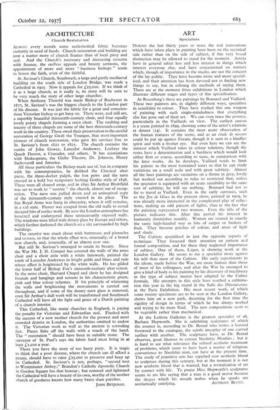ARCHITECTURE
Church Restoration ALMOST every month some ecclesiastical fabric becomes violently in need of funds. Church restoration and building are now a matter more of church finance than of local piety and zeal. And the Church's necessary and increasing concern with finance, the endless appeals and breezy sermons, the appointment of more and more " business bishops " tends to lessen the faith, even of the faithful.
St. Saviour's Church, Southwark, a large and partly mediaeval building on the south side of London Bridge, was made a Cathedral in 1905. Now it appeals for £25,000. If we think of it as a large church, as it really is, its story will be seen to be very much the story of other large churches.
When Anthony Thorold was made Bishop of Rochester in 1877, St. Saviour's was the biggest church in the London part of his diocese. It was just the fabric for a great and conscien- tious Victorian bishop to get busy on. There were, and still are, a superbly beautiful thirteenth-century choir, and four equally lovely priory chapels forming a retro choir. The vaulting and tracery of these chapels are some of the best thirteenth-century work in the country. These owed their preservation to the careful restoration of George Gwilt the Younger, that most important pioneer of church restoration, who gave his services free to St. Saviour's from 1822 to 1825. The church contains the tombs of John Gower, Lancelot Andrewes, Lockyer the Quack Doctor, a Crusader, and others. It has associations with Shakespeare, the Globe Theatre, Dr. Johnson, Henry Sacheverell and America.
All these particulars the Bishop made use of, but in company with his contemporaries, he disliked the Classical altar piece, the three-decker pulpit, the box pews and the nave erected in a bold but temporary looking Gothic style of 1838. These were all cleared away, and in 1890 Sir Arthur Bloinfield was set to work to " restore " the church, almost out of recog- nition. The nave was pulled down and an uninspired copy of the thirteenth-century style erected in its place. The fine Royal Arms was hung in obscurity, where it still remains, in a sad state. Plaster was scraped from the old walls to reveal decayed bits of earlier work. By now the London atmosphere has loosened and endangered these unnecessarily exposed walls. The windows were filled with dreary glass by Kempe and others, which further darkened the church on a site surrounded by high buildings.
The exterior was stuck about with buttresses and pinnacles and crosses, so that the whole effect was, externally, of a brand new church, and, internally, of an almost new one.
But still St. Saviour's managed to retain its beauty. Since the War Mr. J. N. Comper has covered the walls of the retro choir and a choir aisle with a white limewash, painted the tomb of Lancelot Andrewes in bright golds and blues and reds whose effect is .heightened by the white walls. He has gilded the lower half of Bishop Fox's sixteenth-century altar screen. In the retro choir, Harvard Chapel and choir he has designed frontals and hangings and screens in his characteristic green, pink and blue colour schemes. If his principle of whitening the walls and brightening the monuments is carried out throughout, and if some of the dreary nave glass is removed, even Sir Arthur's dull work will be transformed and Southwark Cathedral will have all the light and grace of a Dutch painting of a church interior.
This Cathedral, like many churches in England, is paying the penalty for Victorian and Edwardian zeal. Flushed with the success of a new mother church for the poorest and most crowded district in London, the authorities omitted to endow it. The Victorian work as well as the ancient is corroding fast. Pieces flake off the walls with a touch of the hand. The " restoration " should have been in suitable stone. The surveyor of St. Paul's says the fabric fund must bring in at least £1,000 a year.
There you have the story of too hasty piety. It is tragic to think that a poor diocese, where the church can ill afford a penny, should have to raise £25,000 to preserve and keep up its Cathedral. St. Saviour's is not, perhaps, " second best to Westminster Abbey;" Brandon's Catholic Apostolic Church in Gordon Square has that honour; but restored and lightened the Cathedral will have a beauty of its own, worthy of the mother church of goodness knows how many braire slum parishes.
JOHN BETTEMAN.






























































 Previous page
Previous page